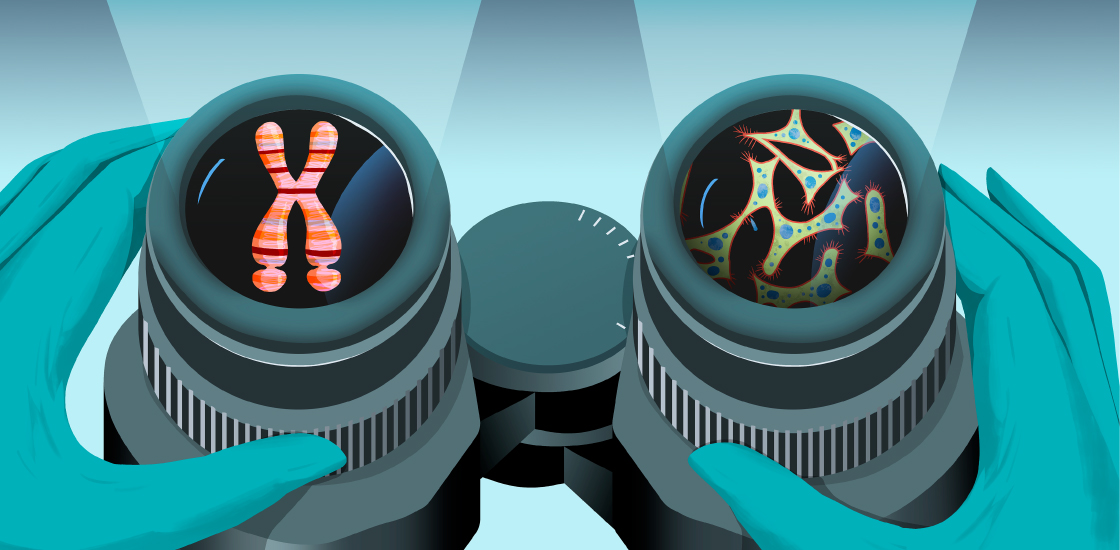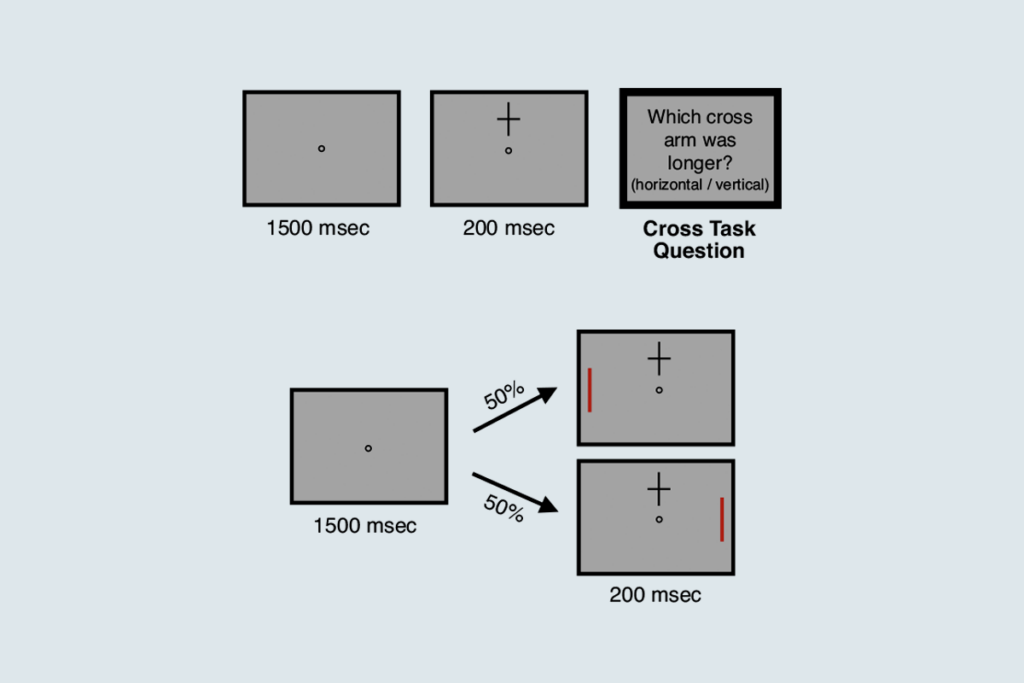About 20 years ago, Claudia Bagni and her team made a curious discovery: FMR1, the gene underlying most cases of fragile X syndrome, was strongly expressed in human cancer tissues.
At first, Bagni brushed it off as a fluke. FMR1 had no known roles in processes related to cancer, such as cell proliferation. But over time, she started to see evidence for a connection build. According to her own findings and those of other scientists, as well as a handful of small epidemiological studies and case reports, it seemed that people with fragile X, the most common form of inherited intellectual disability, might be protected from cancer.
“Those initial clinical reports marked for our group the beginning of a new, completely unexplored [research] area connecting neuroscience and cancer biology,” says Bagni, now director of fundamental neurosciences at the University of Lausanne in Switzerland.
In the past decade, Bagni and others have shown that several different types of cancer — including colon cancer, liver cancer, pancreatic cancer and melanoma — involve increased levels of FMRP, the protein encoded by FMR1. In a mouse model of breast cancer, having high levels of FMRP in tumors is linked to the spread of the cancer to other areas of the body, including the lungs, according to a 2013 report. And the list keeps growing.
Bagni’s latest study, published last month in Cell Death & Disease, identified high levels of FMRP in tumors from people with glioblastoma, an aggressive cancer of the brain or spinal cord. The patients’ FMRP levels tracked not only with tumor growth but with their overall survival. What’s more, overexpressing FMRP in glioblastoma stem-like cells, which are thought to be involved in tumor initiation, also boosted cell proliferation in a lab dish.
The new results reinforce FMRP’s link to cancer and the idea that people with fragile X syndrome may have an unusually low risk for it, says Randi Hagerman, medical director of the MIND Institute at the University of California, Davis, who was not involved in the work. People with fragile X, who often have autism as well, have mutations that silence FMR1 and prevent cells throughout the body from producing FMRP.
“[The new work] also suggests a new treatment for glioblastoma, which is a terrible kind of cancer,” Hagerman says.
But research on exactly how FMRP levels might influence a person’s cancer risk is still in its infancy — and how to investigate the connection to fragile X isn’t straightforward, says Nien-Pei Tsai, associate professor of molecular and cellular biology at the University of Illinois Urbana-Champaign.
“It needs much more work to say that people with fragile X syndrome have a lower risk of developing cancer,” Tsai says, noting that FMRP is lost during development, and its long-term absence could lead to compensatory effects later on.
“When compensatory effects are in place, the correlation between the levels of FMRP and cancer progression may not be the same anymore,” he adds. “There is no easy way to test how [fragile X syndrome] may reduce risk for cancer.”
E
pidemiology studies might seem like the most direct way to establish the cancer-fragile X connection. National registries, such as those in Sweden, Denmark and Finland, track the condition as well as newly diagnosed malignancies, says Sven Sandin, a biostatistician at the Karolinska Institutet in Stockholm, Sweden. With that information, he says, “it’s not that tricky to do a straight-on analysis.”But, he notes, potential confounds abound: “If we have an increase in fragile X diagnoses because of increasing awareness and testing, and if at the same time we diagnose more children with cancer, that by itself would create a spurious association,” he says.
It’s also difficult to definitively connect the dots through FMR1. The FMRP protein binds to hundreds of RNA molecules in the brain and other tissues, affecting numerous signaling pathways — some of which help regulate brain development and are also implicated in cancer development.
The cancer connection is not unique to FMR1. More than 40 genes associated with autism, including PTEN, TSC1 and TSC2, have links to cancer. Studies suggest that some autistic people have decreased odds of developing cancer, although those with co-occurring intellectual disability or birth defects are at a higher risk of cancer early in life than are non-autistic people, according to an April report.
“If cancer genes were not involved in autism, it would be a miracle: They are all over the place … they’re involved in virtually every aspect of signal transduction that occurs in the organism,” says Michael Wigler, professor of cancer research at Cold Spring Harbor Laboratory in New York. “There’s no simple story here.”
Yet the link to fragile X seems particularly robust, based on reports collected over the past 20 years. Among 223 Danish people with fragile X syndrome, only three had cancer, according to a 2001 study. This proportion is about 70 percent lower than what’s expected in the general population. Another study, conducted in Finland, found that 11 out of 302 people with fragile X had cancer — about 20 percent lower than what’s expected in the general population.
A third report described the case of a boy with fragile X who developed an inoperable form of glioblastoma, but who survived for at least eight years after the cancer diagnosis, with the tumor growing at a lower-than-expected rate. Children with glioblastoma typically survive one to six years after diagnosis, and less than 20 percent survive five years after diagnosis.
A range of mechanisms could be at play: Two genes overexpressed in people with fragile X are related to tumor suppressors, a 2010 study found. And among the genes whose levels were decreased in more than half of people with the syndrome in that study, one encodes a component of the Wnt/beta-catenin pathway. This pathway regulates cell growth and has been implicated in both cancer and neurodevelopmental conditions such as autism. Bagni’s latest work on glioblastoma also hints at Wnt involvement: Reductions in FMRP levels, she and her colleagues found, dampen Wnt signaling.
“If you’re trying to identify converging pathways, Wnt signaling could be one of them,” says Peng Jin, professor of human genetics at Emory University in Atlanta, Georgia.
B
ut FMRP also targets vimentin, a protein that is associated with increased metastatic potential, Hagerman says. “Vimentin allows the cancer to invade tissues, and if FMRP is high, it suggests there might be metastases too.”And another FMRP target is MDM2, a protein that hinders the maturation of neurons and is expressed at increased levels in people with fragile X syndrome. A compound being tested in cancer clinical trials, nutlin-3, inhibits MDM2 and boosts the number of mature neurons in a fragile X mouse model. It can also reverse cognitive and behavioral difficulties in the model, according to a study published in May.
“We were looking for molecular pathways that could be modulated to correct what is dysregulated in the mice,” says lead investigator Xinyu Zhao, professor of neuroscience at the University of Wisconsin-Madison. “It turns out that some of them are indeed cancer drug targets.”
Singling out any of these potential contributors could prove difficult. FMRP appears to have certain functions in some types of cells and not in others, says Ethan Greenblatt, assistant professor of biochemistry and molecular biology at the University of British Columbia in Canada. It may also have cell type-specific functions in cancer, affecting only some cancers.
And whether children with certain neurodevelopmental conditions are at higher or lower risk for malignancies may depend on the nature of the molecules involved, Jin says.
“FMRP acts as a brake to suppress protein translation, whereas other molecules could be involved in gene activation,” he says. “Different molecules can play distinct roles in regulating neuronal function as well as cell proliferation.”
Ultimately, Wigler says, a link may exist between FMRP and only some malignancies, with no direct tie between cancer and fragile X syndrome or other neurodevelopmental conditions.
Regardless, looking at that tie could lead to fresh therapeutic targets for several conditions. “Something that downregulates FMRP could help with glioblastoma … and downregulation of FMRP may be really helpful for many other cancers,” Hagerman says. And, Bagni adds, identifying molecular pathways downstream of FMRP that are dysregulated in cancer cells could also lead to more targeted treatments for fragile X.





